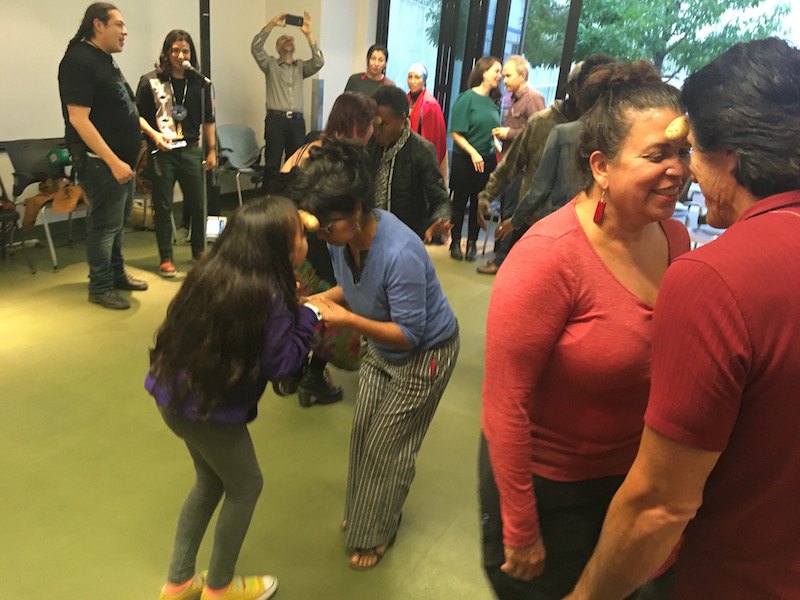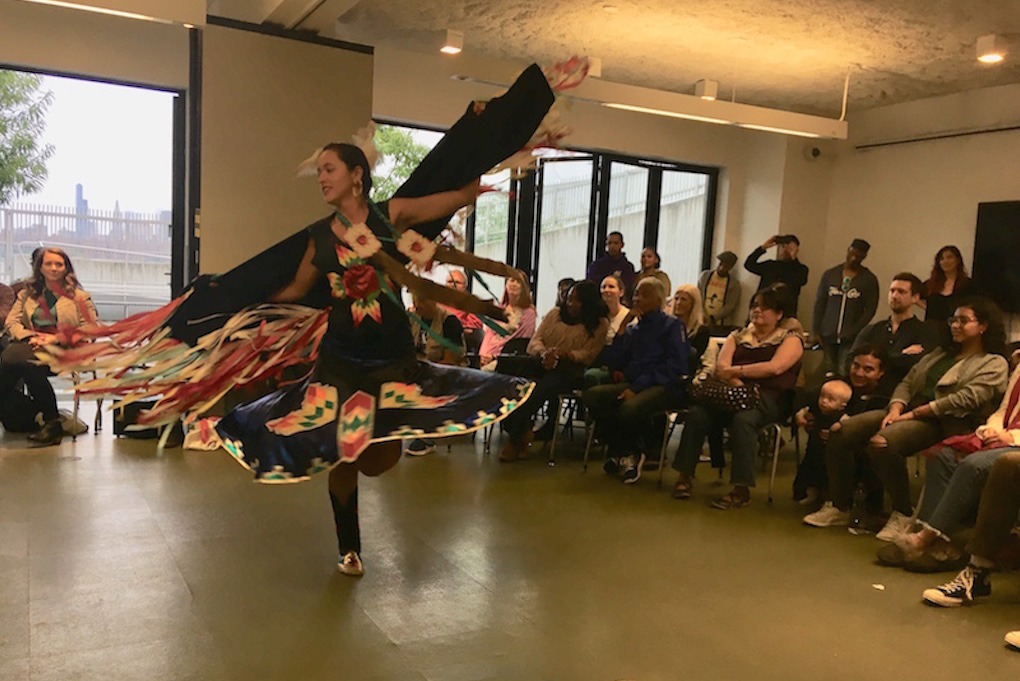Bobi Morgan Wood
Contributor
The Indigenous Peoples Day Symposium, Seeds of the Future, was held Saturday, October 6, at Transmitter Park in Northern Brooklyn.
Rick Chavolla, Kumeyaay Nation, Board Chair of the American Indian Community House (AICH), opened the event with a Land Acknowledgement and Opening Blessing.
He gave a lecture on Foundational Concepts of how indigenous people conceptualize their relationship with the land, which includes not only the ground we walk on, but all of nature, including oceans, rivers, plants, animals, and people. “Every single thing we do is in relation to [this],” Chavolla explained.
“It’s essential that we give thanks to the land that we’re on…It’s important to know that this land that we’re on was an incredibly verdant, vibrant area to the native peoples,” Chavolla said, who stressed up front “I do not speak for all native people.”
Throughout the afternoon, speakers respectfully referred questions from the audience to experts from another tribe who could more accurately answer the particular question.




Although the program flier labeled his first talk ‘Past, Present, and Future,’ Chavolla pointed out with no small amount of irony, “We are not linear, that’s not actually how we conceptualize time, but that’s a discussion for another day.”
“When we talk about who we are in relationship to the land, we are not talking about it in a possessive way, in an acquisitive way, in a consumerist way. It is not an object to be consumed, acquired, or owned,” Chavolla said.
Chavolla provided an overview of Pre-Contact and Post-Contact, detailing how the European-carried diseases, devastating after the military invasion, were then amplified with the large-scale environmental devastation that occurred. Pigs brought over from Europe bred rapidly and ate up all of the natural vegetation, and the environmental degradation—including deforestation— contributed to the spread of disease.
“100 million acres was transferred away from our stewardship, from our oversight, over the 60 years of the Dawes Act.”
Chavolla also related that although most people know about the Standing Rock pipeline, not many know “There are pipelines running right through this area.”
The messages were impactful for many visitors throughout the day that more than one attendee wiped away tears as they addressed the rest of the room. Chavolla explained that it was their goal “to follow land as the guide for our lives, to stop the extractive industries. There is still a sense that we live in a way which is not as important, whether it’s fracking, tar sands, or whether it’s pipelines.”

“We’re hoping this will provide some education.” Chavolla said of the day’s event, “And to share our enjoyment of our culture. Learning certainly can be enjoyable. I think people forget, we’re a goodwill people. Tribal people welcome first. Then, when things go bad, they think, how can I defend my land?”
NAMY nominated Native American pop musician Tony Enos of the Cherokee Nation performed a dance song that told the story of the Cherokee Removal Act.
“It’s not about guilt, it’s about action,” Enos told the room, echoing the words spoken earlier by Rick Chavolla.
Katie Naplatarski of Friends of Transmitter Park, one of the partner organizations for the event, reminded attendees that “What you see here was not here 20 years ago—it was the remnants of manufacturing”—sharing that, when people come together to apply pressure, meaningful, positive change can be made.

Tecumseh Ceaser gave a lecture on pre-colonial context and knowledge of values, and Wampum. Ceaser, who is Matinecock Tribe of Queens and Long Island, Wamponowag Pokanaoket band, Montaukett, and Blackfoot, explains that this geographic area, including Brooklyn, Queens, Long Island, and Manhattan, is called The Island of Shells on the Turtle’s Back.
“To give you guys more context, Brooklyn is part of Long Island,” Ceaser explained.
“The thing to know about Native Americans is that we are a migratory people,” he stated, “We have the idea, this understanding, that if we stayed in one place for too long, we would eat up all the resources.”
Indigenous peoples have historically moved every 10, 20, or 30 years, didn’t over hunt or over fish and rotated crops.
Performers and presenters included a Women’s Powwow dance presentation by Tohanash Tarrant and Josephine Tarrant.
Storyteller Joan Allison Henry changed up the energy of the room. Henry had the audience put away their cell phones, and move the chairs into a giant circle; performances after that were intimately performed in the round. Ty Defoe, Ojibway/Oneida Broadway actor, got everyone in the circle out of their chairs and onto the dance floor as participants in dances—after having each person slowly look around the room and hold the eyes of each other person for a few precious moments of intimacy– which is rare when everyone is perpetually looking down at their phones.

Chavolla said that at The American Indian Community House, they are frequently asked, “How can I help?”
“One thing we can do here in New York City is get involved in the divestment movement, Chavolla said. “We can do work to challenge, to resist, to stop these huge financial channels that do incredible damage to our land, to our Mother Earth.”
Mayor Bill de Blasio recently worked with AICH to divest from Wells Fargo Bank, which was celebrated by environmental activists in the city.
“You as settlers need to acknowledge that you are on our land. You are on stolen land. You are on land that was not arrived at using legitimate means,” said Chavolla. “It means action, not guilt. Not feeling bad, but moving yourself to action.”
Photos by Friends of WNYC Transmitter Park


